NOTE: This post has been updated since the original review! new comments in italics.)
Tonka is stuck in his stall for the foreseeable future. He has a fractured phalanx (a bone deep inside of his hoof) and a bit of that bone is stuck to his collateral ligament. He hurts. He needs a lot of time to heal. Fortunately, Tonka is already in the ideal boarding situation for a longterm layup. He has a large (12 by 12 foot) stall, a door to the aisle that he can hang his head out of, and a Dutch door to a small attached runout. However, he’s not even allowed to have that open and go between the stall and tiny paddock. Either he’s out there, or he’s inside. (Note that I keep his paddock shoveled, raked and flat. This injury requires that much attention to footing.)
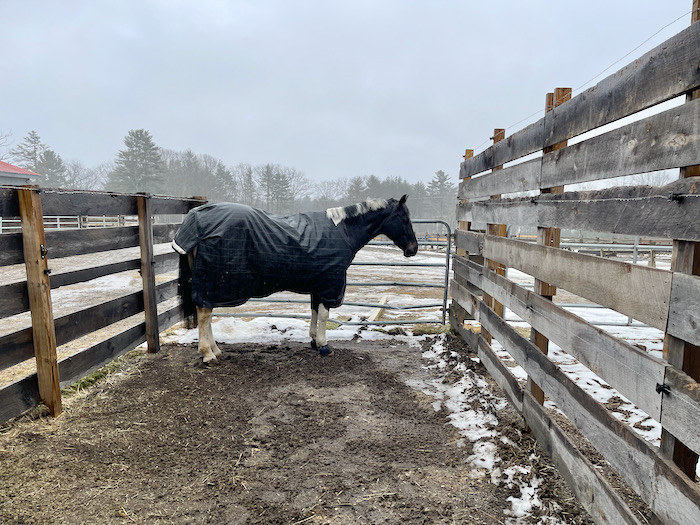
My horse is sane and intelligent. I’ve spent much time with him, teaching him to self-calm. But months upon months of being confined can make any horse bonkers. Tonka was spending most of his time with his head in the aisle, bright-eyed, and nickering for attention. He wasn’t banging on the door, or getting into trouble, but I could see the energy. A horse should spend most of their day relaxed, not eagerly looking for something to do.
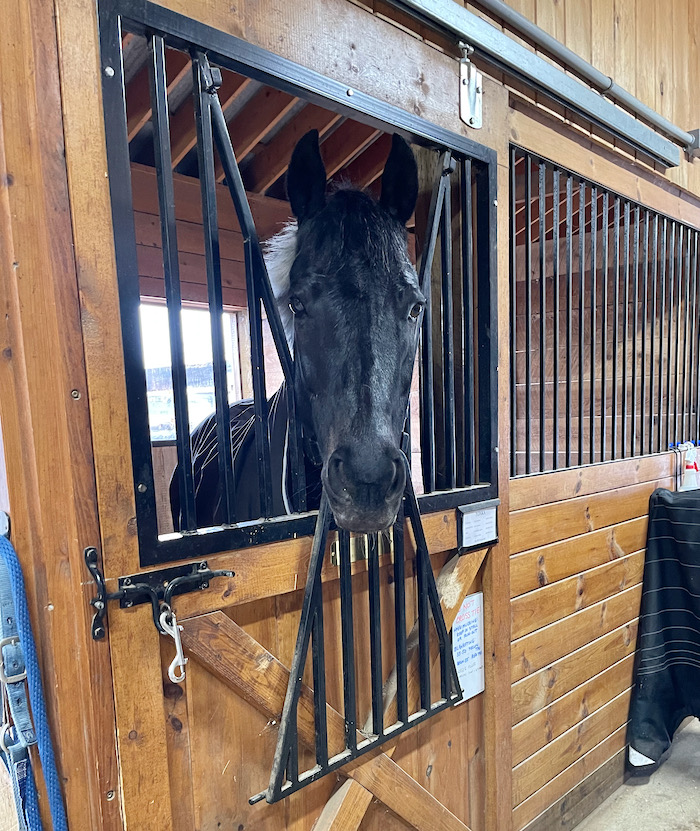
Tonka isn’t one much for toys. He mostly ignores the Likit and the rolling salt block that I got him.
What helps to settle Tonka, and really most horses, is lots of forage. Tonka’s barn feeds hay five times daily, but even that much (about 6 flakes daily) was eaten up quickly. Tonka, although eating the right amount, wasn’t chewing enough, and he had way too much spare time. Horses, in a natural environment that they evolved for (sparse grasslands) eat about 16 hours a day. They don’t sleep through the night. They eat. Or should be eating. Nor do horses in their native habitat stand still and gorge. A horse takes a bite, walks a step, takes another bite. And on and on. One solution is to use a slow feed hay net, but I’m not a fan of most of those. Horses are designed to eat with their heads perpendicular to the ground, not reaching up and twisting and pulling hay out of a bag. A few years ago Tonka was boarded at a stable that fed the horses from hanging hay nets. That caused Tonka to develop bursitis in his poll, arthritis in his neck, and have sacroiliac issues. So, I wasn’t about to use a net for Tonka now, no matter how much I want him to have hay in front of him all of the time.
I decided to get the Haygain Forager. It looks like a fancy garbage can. The horse reaches in and down to pull the hay up out of the grid, which mimics how they naturally graze. It’s expensive ($390 list price) but I decided that it would be worth it if Tonka could eat slowly throughout the day and night. Along with his mental health, I’ve been concerned about his gut health. The thought of colic (a term for a broad range of painful digestive tract issues, none of which are good, and some of which are lethal) scares all horse owners, and horses that are confined, stressed and not eating frequently enough, are prone to it. If the Forager worked, then my mind (and his tummy) would be more at ease, too.
The Forager is big. Putting it together isn’t too complicated. But I did cut myself on a sharp edge on the plastic rim. Steve filed it down so that human and horse wouldn’t be further injured.
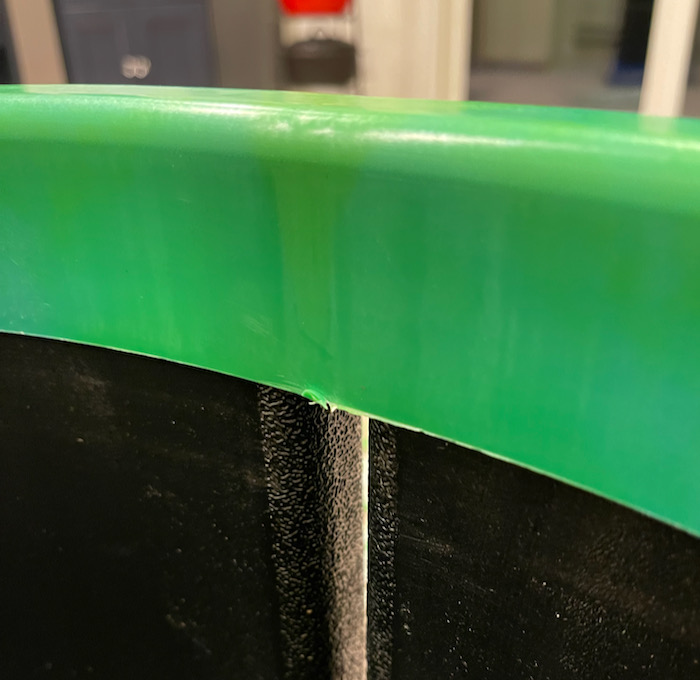
It’s very sturdy. Perhaps too much so, because removing the grid to fill the bin is both awkward and difficult. The plastic isn’t flexible enough to do it easily, and snapping the ring onto the grid takes effort that my old cold hands in the winter aren’t quite up to. Over time, though, the parts are becoming more pliable and I’m figuring out tricks to make filling it a tad less frustrating. I’m learning exactly where to hold the pieces so that I can get them to snap into place. At this point it’s too complicated and time-consuming to ask the staff at the barn to fill. If it’s empty, they put a flake on top of the grid. Which is okay, but not ideal. I’m at the barn daily, and so far Tonka hasn’t gone hungry. I’m hoping that with time the Forager will continue to become easier to use. Even with the difficulty with the filling, the barn owner is interested. There is zero waste and hay is expensive and getting more so. The Forager might be the ideal solution to feeding the horses who live outside in sheds.
From Tonka’s perspective, it’s a great design. The grid is flat and doesn’t appear to harm his teeth (some slow feeders wear gouges out of front incisors). (Update: The veterinarian who takes care of Tonka’s teeth is board certified equine dentist, and she doesn’t like anything hard plastic, not grazing muzzles or this forager. See later in the post what I did.) The whole thing doesn’t budge as he eats from it. (I keep it tied to the wall just in case.) (The tying didn’t work. The top of the forager popped off. It requires two eye hooks at the level of the top of the Forager. Then I used loops of baling twine attached to double-ended snaps attached to the eye hooks.)
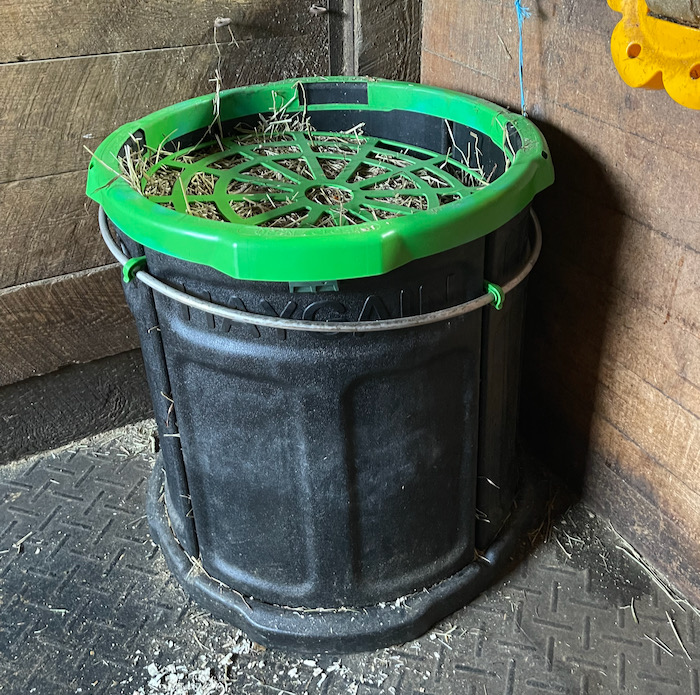
The grid slows down how fast Tonka can eat, but he’s not frustrated. When Tonka was fed his hay in a slow feed net, he’d look ticked off, and would do all sorts of things to try to make the net easier to get the hay out of (see this blog post), but that’s not happening with the Forager. Tonka stands still, looking at ease while dining. (This is a nice long video because watching a horse eat is a pleasure I want to share with you!)
Tonka is no longer spending so much time at his stall door, and there are days when he knows I’ve arrived, but he’s not there to nicker a greeting. That’s fine with me. I’d much rather see a horse on stall rest hanging out with this sort of body language.
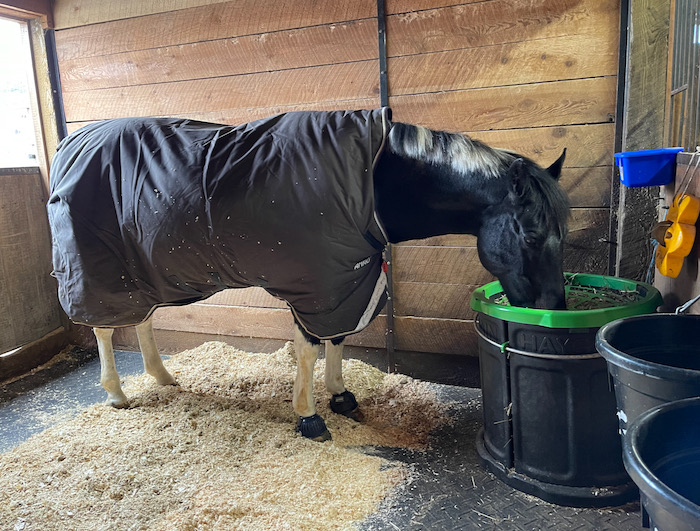
Another plus is that it’s got to help with his gut health. Horses are prone to impactions when they are standing around. Having small amounts of food constantly moving through his system is a very good thing. I keep an eagle eye on amount and quality of manure that Tonka produces, and I like what I’ve been seeing! That, plus how relaxed Tonka is, has convinced me that the Forager is good for my horse’s well-being. Yes, it’s not the easiest thing to fill, but I’m getting the hang of it. The raw skin on my hands, where the Forager has pinched me time and again while trying to remove the grid, then put it back together, is healing, and I haven’t had to get a bandaid out for a few days now! But it never was easy to fill, and it was too time-consuming and awkward to have the barn staff learn how to do it. So, if I wasn’t around, hay was simply tossed inside. In conclusion, so far, the Forager has been a success.
BUT… for whatever reason, the cold? The trying to wrangle the grid when filling? The grid broke several times. HayGain customer service was awesome and sent me replacements, but those snapped too. So Steve cut off the grid, but left the outer ring. He then cut a hay net to fit, looped it on with cord, and voila! we had a teeth-safe grid that had no hard broken plastic pieces. Carabiners are on the green inner grid where the barrel’s slots are, and those attach to the outside ring with double-ended snaps. It’s now easy to fill, safe for Tonka’s teeth, and hasn’t broken.
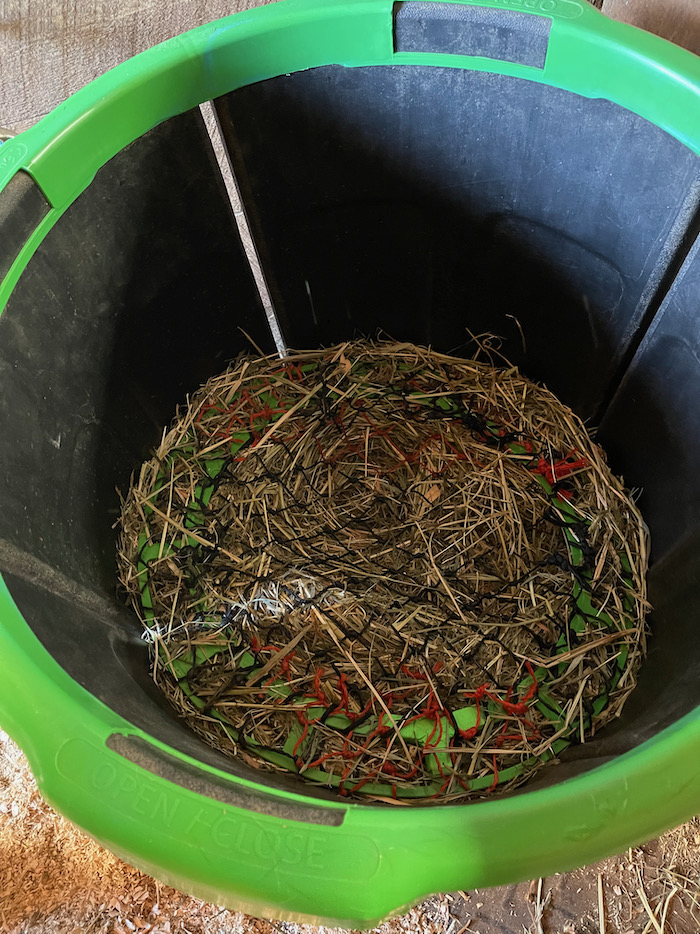
Tonka is no longer on stall rest, but he will continue to be fed in the Forager. It’s the only slow feeder that allows the horse to eat in a natural grazing position. Tonka looks so relaxed eating his hay out of it. I also appreciate that there’s no wasted hay and the stall stays very tidy. So, with modifications, it’s a keeper.
Have you had success with this or similar feeder, perhaps the Porta-grazer? Let me know in the comments!


Happy New Year, Terry and Tonka!
Let’s hope for good healing and happy days ahead for dear Tonka – just watched the lovely video and enjoyed listening to that contented chewing!
I never tire of watching him eat hay or graze.
Lance has destroyed the big, sturdy corner feeder in his stall (which was originally Ollie’s); he’s a horse that gobbles down everything you give him as quickly as possible and then gets bored. This looks like a possible solution, but I have my doubts about how long it would last; Lance works on things with teeth and front feet.
I wish that they’d have some sort of guarantee for horses like Lance.
Happy New Year to you all. Keeping everything crossed for Tonka, l now it will be a slow recovery but he has a caring family and is in the best place for recovery. Very intrigued by the Hay Forager, what is different about green and grey regulator does not explain in description and they look very similar.
The green one has smaller openings, so slower eating.
Happy New Year Terry to you and your family, human and animal and to your readers. That looks like a great solution for Tonker. It seems to emulate grazing as much as is possible and Tonker looks happy.
Happy New Year to you too!
This looks like something I might be interested in for one of my horses.However, I can’t ask the owners of the barn to go through the hardships of filling it.I am not close enough to fill it daily or every two days,etc. I wonder if the Porta-grazer would be easier to fill. If anybody knows the answer to this question, please post. My husband can put it together.
Yes, Portagrazers are easy to fill. One handle has an arrow on it. The insert has a small hole on the vertical portion. Line up the hole with the arrow and lift the insert out. Ours are fastened to the wall by the handle that had the arrow on it so you just spin the insert until it’s lined up and lift up. I put in soft flakes of hay just as they are. Firm flakes, I break up a little to make them easier to pull thru the holes. That also depends on the individual horse and the size of the holes in the insert. Our horses have Portagrazers, hanging hay bags and I also use hay ball toys as well as hay cube toys so they eat in a variety of postures.
Can you give more detailed info on how you did the haynet? I can’t see how it was hooked with the carabiners. I assume you also cut off the plastic hooks that clip to the metal circle?
Yes -the plastic hooks were cut off. The inner grid was also cut off, so that all you have is a wide plastic circle. Edges had to be filed as cut plastic can be sharp. The hay net was attached using cord. Tied on with skills my husband -the boy scout leader- has. I attached doubled-ended clips to the metal circle, one half of which are pushed through the slots. The inner ring has the carabiners. When I fill the Forager, I unclip 2 of the carabiners. Once done, it works great!
I used a porter grazer for soaking hay and then feeding it while my horse was on stall rest. As a soaker, it’s amazing. There’s a drain at the bottom and simply drain the water out and the wet hay stays in the feeder. But I didn’t like the slow feed top. like many of the other commenters, my horse got frustrated with trying to get the hay out, and actually used his teeth to try to get rid of the top. Thus he created small burrs all around the plastic holes and started cutting his lips.
I found your post after seeing a photo of the forager – and I had my doubts that the plastic rings would hold up. I like your solution but for close to $400, you shouldn’t have to re-engineer the product.
I agree that I shouldn’t have to find a fix – especially for such an expensive item. I still use the forager. It is currently out in Tonka’s pasture. The owner of the the barn tosses hay in without using the grid. Sometimes she just tosses hay on the ground. Putting hay in keeps it the (expensive!) hay from blowing out of his field. When I visit, every couple of days, I fill the forager, using the grid. Tonka seems to prefer pulling hay out of the grid, even more than the loose hay on the ground. So, despite it all, I would buy it again – for my horse’s specific situation.